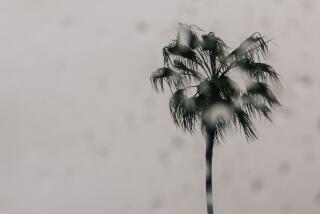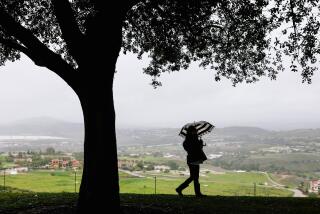Nora Sweeps By, Bringing Rain and Floods
Still-powerful remnants of former Hurricane Nora invaded Southern California from Mexico on Thursday, triggering floods, knocking out electrical power, snarling traffic and generating tide-boosted waves that swamped several homes in Seal Beach.
Nora, downgraded to a tropical storm as it moved inland, still packed quite a punch, dumping as much as two inches of rain in the low-lying Imperial Valley and up to four inches in the mountains of San Diego, Riverside and San Bernardino counties.
Rainfall was generally lighter, but still substantial, in Los Angeles and Orange counties, where the circulating fringes of the cyclonic tropical storm dropped generally gentle but persistent showers throughout the area.
Light sprinkles began falling on Los Angeles shortly before dawn Thursday, ending a dry spell that had lasted a record-shattering 219 days. The 0.45 of an inch of rain that had fallen on the Civic Center by nightfall was the first measurable precipitation since Feb. 17, when 0.02 of an inch fell downtown. The old record--197 days--was set between April 12 and Oct. 27 in 1927.
Nora’s diminishing strength spared Southern California the sort of widespread devastation that the storm had wreaked on Mexico’s Baja California.
The worst problems in the Southland apparently occurred in the Orange County community of Seal Beach, on the outer fringes of the storm.
Orange County officials said high tides boosted waves generated by Nora and a storm far to the north, sending breakers 20 feet tall crashing into beachfront homes in low-lying areas of the city.
Three houses were seriously damaged and 45 others received minor damage as water gushed through garages and patios.
Dave West, who lives on 12th Street, bolted out of bed at 4 a.m., thinking, at first, that an earthquake had occurred.
“I heard a rush of water and felt a pounding,” West said. “I looked outside and the water was streaming across the street. . . . By 6 a.m. I had two feet of water in the hallway,” West said.
Kathleen Nelson, who lives on Ocean Avenue in a neighborhood hard-hit by flooding, said the experience was “scary.”
“Standing in the alley, you could see the waves coming at you,” she said.
Sleepy residents and barefoot surfers scrambled to fill and stack sandbags, while bulldozers hastily constructed a sand berm that stretched for six blocks in front of the flooded area.
Lifeguards closed the beach at 9 a.m. to keep people from being injured by heavy machinery, but surfers were allowed into the extraordinarily large surf.
“These are the best waves these guys have seen in years,” said Fire Authority spokesman Dennis Shell.
Residents of Yuma, Ariz., where the storm entered the United States, had prepared for the worst, piling up more than 75,000 sandbags to divert what many had predicted would be a devastating flood. School was canceled, city employees were put on emergency alert, and residents in 240 homes in the farm community of Somerton, near the Mexican border, were evacuated to a Red Cross shelter.
The flooding came, but it was confined mostly to streets and low-lying vacant lots. By midafternoon, the rain had stopped and workers were able to rest.
Said Roger Brooks, an official with the city/county emergency response team: “We’ve been preparing for the worst, but the worst didn’t happen.”
The same sense of relief was evident in California’s nearby Imperial Valley. Streets were flooded, 35,000 sandbags were deployed, and minor structural damage was reported in Heber, Seeley and Salton City, but Nora was not as wicked as predicted.
“We were lucky. The rain was steady but it didn’t have those sudden bursts that can cause so much trouble,” said El Centro Fire Capt. Steve Wilson. “It was just a steady warm rain. It was like being out in a shower.”
However, agricultural officials in Imperial County, which provides a large share of the nation’s winter produce, estimated that the storm did $4 million in crop damage, mostly to lettuce, carrots, broccoli and cauliflower. That damage could increase if mold sets in, the officials said.
Almost two inches of rain fell in Palm Springs. The runoff flooded several streets in that desert resort city and in nearby Indio, but there were no reports of major damage in the Coachella Valley.
In San Diego, a few streets flooded, but, again, there apparently was no major damage.
The long dry spell had allowed grease and oil residues to build up on Southern California’s streets and freeways, and Nora’s sprinkles turned the roadways into tropical skating rinks during the morning rush hour.
The California Highway Patrol said there were about 230 traffic accidents on Los Angeles-area freeways between 4 and 10 a.m. The rush-hour crush lasted almost until noon as commuters struggled to get around jackknifed big-rigs and multi-car pileups. The light rain, coming after the lengthy dry spell, led to “flashovers” that briefly knocked out electrical service to about 40,000 customers in the city and 85,000 in surrounding communities, according to officials with the Department of Water and Power and the Southern California Edison Co.
DWP spokeswoman Karen Shepard-Grimes said that in many cases, rainwater combined with accumulated dust on insulators to form mud that shorted out equipment.
Most of the outages in the city occurred near downtown, Hollywood, the east San Fernando Valley and Lincoln Heights. Most customers had power restored within a few hours, officials said.
Health officials issued a rainy-day warning for Los Angeles County’s beaches, advising people to stay out of the water for the next three days.
Officials said that each time it rains in the Los Angeles area, several billion gallons of polluted urban runoff flow down storm drains and into the sea. Because of the long dry spell, more pollutants than usual have accumulated, county health officials said.
Forecasters said Nora should dwindle into extinction over the Arizona desert early today. Skies in Southern California are expected to clear today, with high temperatures in the Los Angeles area ranging from the low 80s to the low 90s.
Times staff writers Michael G. Wagner and Janet Wilson in Orange County and Jose Cardenas in the San Fernando Valley and Times correspondent Richard Warchol in Ventura County contributed to this story. Malnic reported from Los Angeles and Perry from San Diego.
(BEGIN TEXT OF INFOBOX / INFOGRAPHIC)
Nora Soaks Southwest United States
* Thursday rainfall totals
Los Angeles: .45
Santa Ana: .60
San Diego: .75
El Centro: .84
Needles: .35
Blythe: 1.92
Yuma: 2.77
More to Read
Sign up for Essential California
The most important California stories and recommendations in your inbox every morning.
You may occasionally receive promotional content from the Los Angeles Times.









